

Planting Up Our Front Entrance For Fall! □□□// Garden Answer. PART 2 Containers that Will Last Through Fall □// Garden Answer. Planting up Some Fall Color! □□□ (a.k.a. willing cooler temps to arrive! □)// Garden Answer. Hydro Stones Work! One Year Terrarium Update! □□□// Garden Answer. Trying Out Hydro Stones □□□ // Garden Answer. Low Maintenance Cactus & Succulent Terrarium! □// Garden Answer. Figure 1. Many available products are referred to as “soap,” but not all are appropriate or safe to use for insect or mite pest management. Matthew A.

Borden and Adam G. Dale2 A topic frequently discussed by home gardeners and professionals is the use of soap products to control plant pests. Limited and conflicting information on this topic has resulted in confusion and misuse of products. This document describes some of the different types of soaps and recommendations for proper, legal, and safe use of these products to manage pests. Figure 1. Many available products are referred to as “soap,” but not all are appropriate or safe to use for insect or mite pest management. Q&A: Painting the Gazebo?, Gravel Maintenance, Why I Always Wear My Hair Down! □□□ The Spider Plant (Chlorophytum comosum) is a favorite, houseplant.

It is practically foolproof for novice gardeners. These sturdy little houseplants are easy to care for and hard to kill! They grow with zeal, reproducing babies in even the most challenging of circumstances. In this article, we provide helpful information on growing these simple, cheery houseplants. Read on to learn more. Do you even Science, Bro. DiMeo Blueberry Farms & Blueberry Plants Nursery - À propos. Introduction To Forest Gardening – Image To Repin / ShareImage – Wikipedia lic. under GNU 1.2 This tutorial will give you a fantastic introduction to the idea of Forest Gardening!

– it’s packed full of knowledge and practical advice for anyone new to the subject and will provide further inspiration to those who already have an interest or have started to practice it. Forest gardening (or Agroforestry) is an ancient practice – it originated as a means of encouraging more food and medicinal plants to grow close to human settlements. Making a garden in this way requires us to understand how the natural ecosystem works, the complex ways of nature can take time to learn but it is a very worthwhile and important study – we can use this knowledge to tap into the abundance of food and medicines that nature can provide.
What a marvelous day to visit your... - Old Moss Woman's Secret Garden. Garden Answer - Landscape Makeover Part 2: Planting for Winter Interest & Running Drip Irrigation! □□□ Landscape Makeover Part 2 of 4: Installing Drip Irrigation! □□□// Garden Answer. Landscape Makeover Part 3: Three Shrubs for All Year Interest! □□□// Garden Answer. 100 Pcs Perennials Shade Ground Covering Hostas Plantain Lily – Plant People. Hostas are among the most beautiful and adaptable perennials.
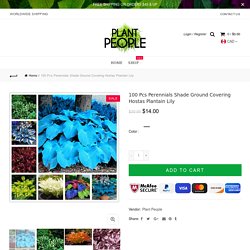
They do well from USDA Hardiness Zone 3 (-40°F minimum) southward as far as zone 9 (20°F minimum). Hostas need a period of cold weather, at the onset of which they turn a pleasing yellow and then go dormant until they reemerge during Spring. Some hostas are native to woodlands and others grow in moist meadows where tall grasses provide some shade. In the garden, one-third shade is ideal. If soil moisture is ample, most hostas can take direct sun, especially in cooler climates and at the northern limit of their range. Full-bloom Period: Mid-Spring to late Fall Type: Perennials Cultivating Difficulty Degree: Very EasyClassification: Novelty PlantsClimate: Zone 3 to Zone 9Size: Medium.
Blossom - We're rooting for these 12 clever plant hacks! April is Kids Gardening Month! □□□// Garden Answer. Garden Maintenance Day: Pruning Hydrangeas, Lavender & Boxwood! □✂️□ Garden Maintenance Day! □□□// Garden Answer. Aquaponics is a marriage of aquaculture and hydroponics together in one integrated system.
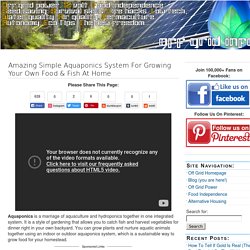
It is a style of gardening that allows you to catch fish and harvest vegetables for dinner right in your own backyard. You can grow plants and nurture aquatic animals together using an indoor or outdoor aquaponics system, which is a sustainable way to grow food for your homestead. The aquaponics system uses a recirculating process to grow plants and farm fish. The fish waste serves as organic food for the growing plants while the plants filter the water in which the fish live. This “symbiotic world” also involves two further critical actors – the beneficial bacteria and composting red worms. For this article, we will be discussing an aquaponics system that is a scaled down version of the one designed by Will Allen of nonprofit urban farm Growing Power Inc.
There are two important factors to consider when deciding upon the final location of your aquaponics system. 1. Photo – Fir0002/Flagstaffotos (Wikimedia) – lic. under CC-BY-3.0 The tragic decline of bee populations has been very prominent in the news recently – and we featured a detailed article about the legal battle over the pesticides which many believe are responsible.
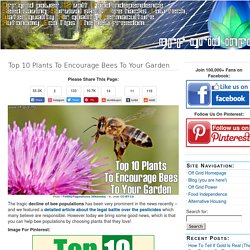
However today we bring some good news, which is that you can help bee populations by choosing plants that they love! 1.
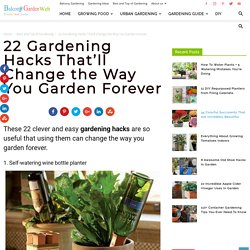
Self-watering wine bottle planter The terracotta stakes are fitted with a wine bottle that is full of water and stuck in the plant’s soil. As the terracotta absorbs the water, it will slowly leak it into the soil and keep the plant’s roots moist. See more wine bottle uses in the garden. 2. Cinnamon has some anti-fungal qualities, and it smells great as a bonus. 3. Curing, Storing, and Braiding Garlic □ // Garden Answer. Planting Garlic // Garden Answer. Harvesting Garlic & Onions + Planting Zinnias! □□□□// Garden Answer. Hoselink Retractable Hose Reel □□ // Garden Answer.
Flowerbed Makeover Start to Finish □□ TreesAreGood.org. Diatomaceous Fossil Shell (aka: DE) is a very common product with a wide variety of uses in industry, around the house and yard.
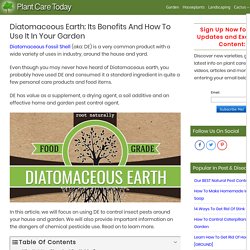
Even though you may never have heard of Diatomaceous earth, you probably have used DE and consumed it a standard ingredient in quite a few personal care products and food items. DE has value as a supplement, a drying agent, a soil additive and an effective home and garden pest control agent. In this article, we will focus on using DE to control insect pests around your house and garden. We will also provide important information on the dangers of chemical pesticide use.
Read on to learn more. Why Not Use Chemical Pesticides? Chemical pesticides (poisons) are the only substances purposely released into the atmosphere for the purpose of killing things. According to the website, toxicactions.org, over 5 billion pounds of pesticides are used in the United States annually. How & What I Use to Fertilize Our Annuals! □□// Garden Answer.
Stupendous Stellar ‘Shrooms!
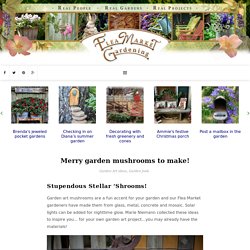
Garden art mushrooms are a fun accent for your garden and our Flea Market gardeners have made them from glass, metal, concrete and mosaic. Solar lights can be added for nighttime glow. Battling Insects & Weeds! □□// Garden Answer. Tips for Planting a Cottage Garden! □□// Garden Answer. June Garden Tour! □□□// Garden Answer. Good evening to you all. We really enjoy... - Enchanted Cottages.
Introduction Modern healthcare professionals are increasingly accepting of the benefits of herbs in treating common ailments.

New drugs are appearing all the time but there is very little knowledge of the long term effects of these – a lot of them contain chemicals that weren’t even in existence a decade ago! Unwelcome side effects are common but are considered a risk worth taking in the pursuit of curing the symptoms of illness. Many of the medicines made by drug companies have their origins in natural plant derivatives so why not go straight to the source? Some herbalists claim that the use of plant material as medicine works in a more balanced way than the isolated active ingredients. Every day we are bombarded with advertisements of the newest pill for pain, fever and many more – resultant of the billions of dollars spent on the health care system.
How to Build a Raised Garden Bed - DIY Raised Bed Instructions. Spring in action! □□□ Gardens should be... - Two Women and a Hoe™ 13 Rose Varieties □□// Garden Answer. Planting Some Roses in my Garden! □// Garden Answer. Soil restoration is the process of improving the structure, microbial life, nutrient density, and overall carbon levels of soil. Many human endeavors – conventional farming chief among them – have depleted the Earth to the extent that nutrient levels in almost every kind of food have fallen by between 10 and 100 percent in the past 70 years. Soil quality can improve dramatically, though, when farmers and gardeners maintain constant ground cover, increase microbe populations, encourage biological diversity, reduce the use of agricultural chemicals, and avoid tillage. Soil restoration begins with photosynthesis. The Power of Photosynthesis Imagine there was a process that could remove carbon dioxide (CO2) from the atmosphere, replace it with life-giving oxygen, support a robust soil microbiome, regenerate topsoil, enhance the nutrient density of food, restore water balance to the landscape, and increase the profitability of agriculture.
The Plant-Microbe Bridge. Garden Answer - Garden Answer a ajouté une photo. 5 tips to get ‘in the know‘ as a Flea Market Gardener! Everyone started somewhere on the quest for garden junk. Maybe you were bitten by the junkola bug at a Flea Market with a friend, or spied something on trash day and unashamedly snagged it for your own, or were influenced by the old familiar belongings, too good to toss, from treasured grandparents. Here's how you can help our fireflies:... - Leslie Nelson Inman. Good Morning! Valerie Waldschmidt says... - Flea Market Gardening. The Sacred Plant. Epic Container Competition: Aaron vs. Laura! □□// Garden Answer. Planting Fire Light Hydrangeas! □□// Garden Answer. Tips From the Tailgate - An Array of Hemp Questions – Purple Cow Organics.
Just in time for Spring planting season, local gardener shares his best tomato-growing secrets - WKOW. 16 Hardy Hydrangea Varieties □□// Garden Answer. PART 2 Containers that Will Last Through Fall □// Garden Answer. Good Morning! Susan Rogers-Garcia says,... - Flea Market Gardening. ATTENTION Rhubarb growers/consumers!... - NDSU Sheridan County Extension Service. The Meyer Lemon Tree, is believed to be the result of a cross between an orange and a lemon tree. This sun-loving tree is robed with attractive green foliage, fragrant flowers and is self-pollinating. It produces delicious tangy citrus fruits as long as it receives enough sunlight and proper care.
Where Did The Meyer Lemon Tree Come From? The original Meyer lemon tree came to the United States from China in 1908. After the introduction, the dwarf-sized plant became very popular. In the 1960s, the majority of Meyer lemon trees in California were destroyed by a virus they carried, which threatened the entire citrus industry. In 1975, the University of California introduced the “Improved Meyer Lemon Tree.” Meyer lemon trees grafted on to a rootstock will produce fruit in about two years.
These fruit trees can grow as an indoor cold tolerant plant in colder zones but grows well outdoors year-round in USDA Hardiness Zones 8-11. Fruits of the Meyer lemon trees contain moderate levels of acidity. Growing enchanted miniature garden scenes Jean Neuweg lives and gardens in Fort Madison, Iowa. When I saw her themed fairy gardens, she made this summer,…in one summer, I was delighted and amazed! She has a talent for finding just the right accessories from very unique sources and making small details herself which we love here at Flea Market Gardening.
Jean’s sense of scale is particularly fine when creating her miniature gardens and they all seem, not too big, not too small,…just right! How to make fairy garden accessories with Jean. Using natural organic fertilizer is nothing new. Years ago, people gardened because their backyard produce was better, cheaper and healthy than store bought. This is a universal truth and the trick behind this is the enrichment of the garden soil with organic matter, compost, and homemade natural fertilizers.
We have all heard of organic gardening. This technique involves producing vegetables and fruits in an all-natural way. Here the nutrients and fertilizers used are organic matter and natural products without involving commercial chemical fertilizer or synthetic fertilizer loaded with harmful chemicals. Flea Market Gardener’s guide to Geraniums… That's because it's National Arbor Day, which people celebrate by planting elms, oaks, pines and basically any type of tree they can get their hands on.
Here's a brief look at how this day of tree appreciation came to be. The Latin word for tree is arbor. Hanging Baskets Part 2: Let’s Talk About Plants! □□□// Garden Answer. Planting Hanging Baskets: Getting Started! □□// Garden Answer. Better Homes & Gardens. Bountiful organic gardens (grown without the use of synthetic chemicals) start with nutrient-rich, organic soil. Spring Planting, Ant Control & Veggie Garden Update! □□□□// Garden Answer. Sensational sunflowers from seed… Sunflowers are one flower that’s pretty much always grown from seed.
The fun of growing vegetables, flowers, shrubs and trees from seeds and cuttings is so rewarding. Blossom - You will wet your plants with these unusual gardening hacks!